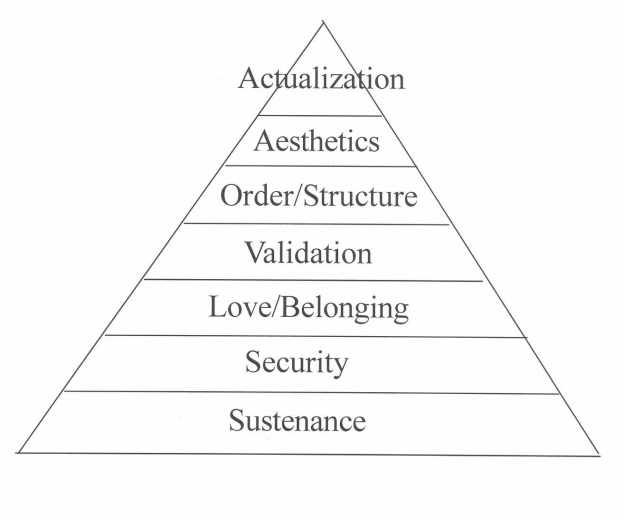
Maslow's Hierarchy of Needs Revisited
by Michael Mallows
[Biodata
and picture of contributor will be found by clicking here]

Having reflected on Abraham Maslow’s hierarchy of Needs in previous issues, I thought it might be interesting to revisit and look at the model again through a cultural lens, so to speak.
The following is a framework I use with actual or prospective trans-racially adoptive parents and foster carers.
I start by exploring how their own childhood needs were or were not met within the context of their own cultural and familial norms. For example, the whole family sharing at least one meal a day at the table. Or, Mum was responsible for the child care and Dad took care of chastisement. Thus, Dad was the one who sent them to their room but he never read bedtime stories. Mum, on the other hand, was blamed for ‘telling tales’ but was not respected when attempting to lay down the law.
Repeated
in the current family dynamic, Dad may blame Mum for being too fussy and
resent having the ‘baddy’ role. Mum could feel that she is not supported.
The kids, meanwhile, on the one hand play them off against each other, on the
other feel very insecure because they know from previous experience that
squabbling parents often results in children being blamed and then removed
from that home.
Although
the discussion may be free flowing, not necessarily a Q & A session, I
will want to explore and determine answers to the following questions:
SUSTENANCE
To what extent do you think that foodstuffs influence a person’s sense of identity?
How might previous experiences of mealtimes affect a person’s new placement?
What are YOUR ‘rules’ for (family) mealtimes?
How
might you respond to a person’s different, ‘inappropriate’ behaviour at
meal times or around food?
SAFETY / SECURITY
A
person may have been moved a number of times and have negative feelings about
black / white authority figures. If the person’s words or behaviour suggest
deep anxieties or insecurities how specifically will your response indicate to
the person that you are culturally sensitive? What specific outcome would you
want from your responses?
LOVE / BELONGING
In
what specific ways would you enable the persons to feel that their emotional,
psychological, cultural or racial selves would remain intact? In what ways
would you actively acknowledge and validate other people’s sense of
belonging to their ‘r
ESTEEM/VALIDATION
In what ways would you actively promote a sense of self, of pride in the person’s sense of ‘their’ culture, race, gender, ethnicity, orientation?
How
would you actively reflect back to the person your pride or pleasure in the
different aspects of his or her origins?
(How?) Do you do that with and for your friends, family and
colleagues?
UNDERSTANDING
What do you think they most need to understand about themselves and their world to achieve more of their potential?
How
- as a parent (or professional) - would you describe or define “the
person’s world”?
ORDER/ STRUCTURE
What are the rules and boundaries? What are acceptable criteria for punishment?
Who
is ‘in charge’ of consequences? (How) do you, as parents, discuss these
issues? What feelings are allowed expression and what are the gender
implications now and historically for each of you?
AESTHETICS
What messages is the person likely to hear from you about Race? Culture? Gender? Abilities? Origins? Ethnicity?
What specific messages will you offer the person to counter the negative or support the positive (above)?
What
specific messages do you give your friends, family and colleagues about the
cultural, racial, ethnic differences that exist between you?
ACTUALIZATION
How
will you help this person to achieve his or her best whilst recognising and
celebrating both the differences and the similarities in your cultural,
racial, ethnic identities?
It is often a revelation for the parents to understand how their different cultural backgrounds impact on their own communication and relationship. These issues may not have entered their minds, and it can be fascinating and uncomfortable for them to recognise, for example, that they have never given thought to the cultural heritage of the young person they will be nurturing.
Many of them, initially, think it’s just Political Correctness and that love will suffice.
Such
attitudes are not atypical, and I want them to have, to some extent at least,
a social constructivist perspective so that they can pay attention and respect
to the unique aspects of a child’s cultural identity. That respect can
encourage parents to learn new approaches and develop new skills. Also, if
needs be, they may build create new networks and alliances that will serve
them as a newly constructed multi-cultural family.
It goes without saying, but I’ll say it anyway, that these questions, suitably adapted, can be applicable in classrooms, board rooms, penal and psychiatric institutions, hospitals, youth groups and anywhere that people with differences congregate or commune. It is even less necessary to mention that the places where these questions or not considered, let alone addressed, are legion!
![]()
Michael Mallows is a Management Consultant, Group Worker, Therapist, Supervisor, Adoption Consultant, Coach and Mentor; also an Author, Lyricist, Public Speaker, Team Builder and Workshop Presenter. [Click on any of the links to learn more about him and his activities] His website is www.mallows.co.uk and Email: michaelmallows@btinternet.com